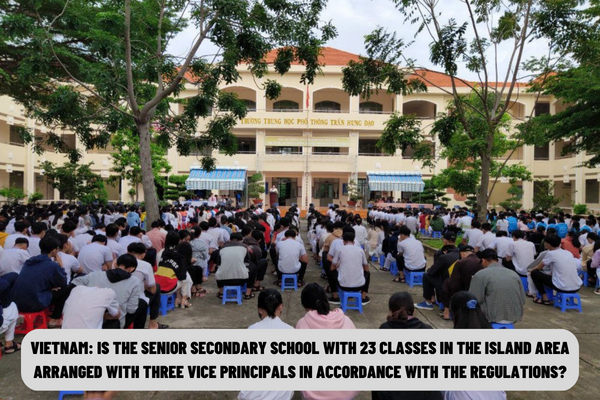Vietnam: Is the senior secondary school with 23 classes in the island area arranged with three vice principals in accordance with the regulations?
What are the public general education institutions in Vietnam?
Firstly, the public general education institutions in Vietnam specified in Clause 2, Article 1 of Circular 16/2017/TT-BGDDT of Vietnam as follows:
Article 1. Scope of regulation and subjects of application
1. This Circular provides guidance on the list of employment position frameworks and the norms on the number of people working in public general education institutions.
2. This Circular applies to public general education institutions, including: Primary school; semi-boarding schools for ethnic minorities at primary level; junior secondary school; semi-boarding school for ethnic minorities at the junior secondary level; district boarding school for ethnic minorities; senior secondary school; senior secondary schools for the gifted; provincial boarding school for ethnic minorities; schools with many levels of education, and schools and classes for people with disabilities.
Thus, public general education institutions in Vietnam include:
+ Primary school;
+ Semi-boarding schools for ethnic minorities at primary level;
+ Junior secondary school;
+ Semi-boarding school for ethnic minorities at the junior secondary level;
+ District boarding school for ethnic minorities;
+ Senior secondary school; senior secondary schools for the gifted;
+ Provincial boarding school for ethnic minorities;
+ Schools with many levels of education, and schools and classes for people with disabilities.
What are the general principles for determining the number of people employed in senior secondary schools?
In addition, according to Article 2 of Circular 16/2017/TT-BGDDT of Vietnam, the principles of determining the number of employees are as follows:
"Article 2. Principles of determining job positions and norms of the number of people working
1. The determination of job positions and the norm of a specific number of people working in public general education institutions must be consistent with the educational tasks and activities of that educational institution and the specific situation of the local.
2. The norm for the number of teachers per class specified in this Circular is the number of teachers to teach all subjects and other educational activities included in the education plan specified in the General education program issued by the Ministry of Education and Training. The arrangement and arrangement of teachers must ensure that schools have enough teachers to teach according to their training majors and that each teacher has enough teaching time limits as prescribed.
3. Secondary schools with many levels of education apply the norms on the number of people working as follows:
a) The norm of the number of people working in employment positions associated with leadership, management, administration and employment positions associated with support and service jobs shall be applied according to the highest grade available in the school and calculated on the total number of classes of all grades;
b) The norm of the number of people working in a job position associated with a teacher's professional activities is calculated according to the norm of teachers in the class corresponding to each grade level.
4. For educational institutions (other than schools for the disabled) that have classes for people with disabilities, the teacher norm shall comply with Point b, Clause 3 of Article 6, Article 7 and the norms of staff to support education for people with disabilities shall comply with Point a, Clause 7 of Articles 6 and 7 of this Circular.
5. The job positions specified in Clause 3 of Article 3, Article 4 and Article 5 of this Circular shall be arranged based on the volume and nature of work to be arranged in the form of public employee recruitment or employment contracts or outsource the work; One person can do many things.
6. For public general education institutions whose teachers are entitled to the maternity regime in accordance with the Law on Social Insurance, the maternity leave period is calculated to supplement the salary fund (if it is missing) of the school to pay the person directly teaching instead."

Vietnam: Is the senior secondary school with 23 classes in the island area arranged with three vice principals in accordance with the regulations? (Image from the Internet)
Can a senior secondary school with 23 classes in an island area have three vice principals?
Pursuant to Point a, Clause 2, Article 8 of Circular 16/2017/TT-BGDDT of Vietnam guiding the list of job position frameworks and the norm of the number of people working in public general education institutions, approved by the Minister of Education and Training issued:
“Article 8. Norms for the number of people working in senior secondary schools
1. Principal: Each school has 01 principal.
2. Vice Principal
a) The senior secondary school has 28 classes or more for midlands, plains and cities, 19 or more classes for mountainous, deep-lying areas and islands; Provincial boarding schools for ethnic minorities and senior secondary schools for the gifted shall have 03 vice principals;
b) A senior secondary school with 18 to 27 classes for midlands, plains and cities, and 10 to 18 classes for mountainous, deep-lying areas and islands may have 02 vice principals;
c) A senior secondary school with 17 classes or less for midlands, plains and cities, and 9 classes or less for mountainous, deep-lying areas and islands may be assigned 01 vice principal.
Thus, for senior secondary schools in the island area with 23 classes, three vice principals will be arranged according to the above regulations.
LawNet
